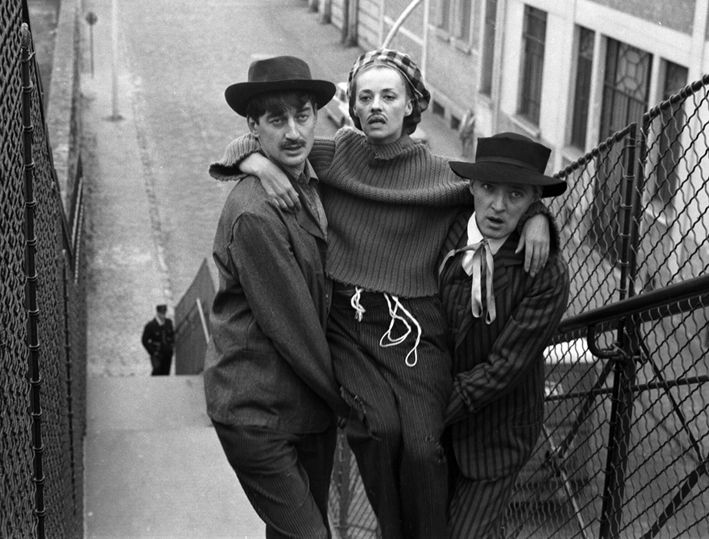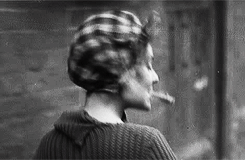Jules and Jim (Jules et Jim) - 1962
Directed by: François Truffaut
Image Copyright: https://www.pinterest.com/pin/385128205625614512/?lp=true
Image copyright: http://eddieonfilm.blogspot.com/2011/04/vision-for-all-perhaps-not-meant-for.html
To simply review Truffaut’s 1962 romantic ménage à trois drama would take much more than a single post. So, I figured I would instead deep dive into the mise-en-scene of one particular scene to showcase the true master piece that encapsulates each second of this film.
This scene in particular is close to the beginning of the film, some might even say the moment when it all starts to go wrong. For the next couple paragraphs or so I will be analyzing Truffaut’s use of mise-en-scene in the scene when Jim goes to Catherine’s apartment to bring her to the train. What ensues is not only a battle of wits, but a battle of power, hysteria, and the heart. A precedent for all that is to follow.
Truffaut uses the intimate setting of Catherine’s quaint, Parisian studio apartment as the setting for the first encounter that includes only Catherine and Jim in a scene, the small space of the apartment conveys the private moment between the two characters as Jim helps Catherine pack for her trip. Truffaut’s mise-en-scene within this encounter encapsulates one of the main themes of Jules and Jim, namely the psychology of desire. The scene shows the beginning of Jim’s desire for Catherine, and Catherine’s true desire of being desired by men.
Catherine purposefully invites Jim to her petite studio apartment, instead of simply being ready and meeting him outside the apartment, so she can confront him with well, herself. Truffaut places the two characters in such an intimate setting, so they have no choice but to interact intimately. Such as, how Catherine has no closed-off room to change clothes in, so, she changes behind a folding screen while talking with Jim the whole time.
However, the mise-en-scene reveals that Catherine’s actions seem pre-meditated. The costume design shows Catherine, calculatingly, opens the door to Jim in her long, white flowing night gown. Not only is the clothing item itself rather revealing and intentional in conjuring images of Catherine in bed, which due to her small apartment is always in the foreground, but the whiteness of the night gown itself carries a deeper symbolic meaning. The white night gown makes Catherine appear virginial and pure, a goddess of virtue, however that image is in sharp contrast with the true seductress she really is.
Yet, as Catherine starts to burn her old love letters right in front of Jim, to show to him how desired by men she is, the flame of the letters starts to also burn Catherine’s pure, white night gown. The burning from the letters onto Catherine’s dress shows both her destructive and self-destructive nature, symbolically the flame from the letters igniting Catherine’s dress on fire burns away her notion of self-perceived innocence.
Catherine then cunningly turns the opportunity of burning her night gown into a reason to have Jim pass her her dress, with the set design placing her dress strategically above Catherine’s bed. The significance of this gesture is not lost on the audience as Jim purposefully walks around her bed to retrieve Catherine’s dress for her, then gently handing the dress over the folding screen to Catherine. The diligent work of props then comes into play as Jim asks Catherine where her broom is, and it happens to be right next to the folding screen, to which after retrieving the broom Jim dutifully (though not asked) starts sweeping away the ashes of Catherine’s burned love letters.
The action of Jim brushing away the ashes of Catherine’s past love letters represents to the audience how Jim will always dutifully dote on Catherine without her even asking him to and how, subconsciously he himself wants to forget about the loves of Catherine’s past, even if he has not realized how deeply he wants her yet. The beginning of Jim’s desires can be seen as he buttons up the back of Catherine’s dress, which she once again purposefully set up for him to, and gently caresses her neck. As if, not realizing how much he appreciates her and her beauty.
The prop design also places Catherine’s sulfuric acid on the table right across from her nearly all-packed suitcase. With the sulfuric acid being the only possession Catherine has yet to pack away. As Catherine diligently goes to place the sulfuric acid into her bag, she is surprisingly chastised by Jim for her naivety to place the sulfuric acid with the rest of her possessions because it could burn everything that she owns. Much like the love letters she had just been burning minutes before.
The scene ends with Catherine racing around the room, doing the last-minute tidying one does before leaving for a trip. However, the mise-en-scene, particularly costume design, within the last seconds of the scene foreshadow a little of what is to come later in the film. In the seconds before Catherine is about to walk out the door she places emphasis on putting on her hat, considerately putting it on as she gazes into the mirror. The emphasis Catherine places on wearing her hat in this moment foreshadows the complete abandon of Catherine’s hat in an upcoming scene when she jumps into the Seine river as a retaliation of being ignored by Jules and Jim. The contrast of these two uses of the hat showing how when she is being paid complete attention to by Jim in her apartment she carefully puts the hat on her head, but when she is being ignored and not desired by both men as they walk after a play she lets her hat float abandoned down the river.
Throughout the scene of Catherine burning her old love letters Truffaut diligently uses mise-en-scene to portray a main theme of the film, namely the psychology of desire. Through setting, set design, costume design, and props, the audience is able to get a glimpse into Catherine’s mental state as a subtle seductress to Jim as well as seeing the beginnings of Jim’s own self-repressed desire for Catherine.
If you have not seen the film (watch immediately) and whether you have seen the film (rewatch, rewatch, rewatch!) because Truffaut’s immaculate directing leaves new hints, clues, and meanings to be found upon every viewing.
In honor of Jim and Catherine, eat a pain au chocolat and drink some cafe au lait while watching. And in honor of Jules…well let’s just say the Germany is not exactly known for coffee or pastries, so drink a nice cold beer for Jules.
Image copyright: https://giphy.com/gifs/francois-truffaut-jeanne-moreau-jules-et-jim-11ZmgvBOjpaCLC


